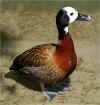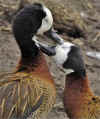White Face Whistling
Tree Duck
|
|
|
Description
White-faced Duck has long neck, long legs and stand up appearance of whistling ducks.
Adult has white face, throat and forehead, from half crown, crossing behind the eyes to the throat, forming a beautiful contrast with black head back and upper nape.
A chestnut wash goes down to the front, until the bottom and the hind neck, and on upper chest. Lower chest, belly and tail are black. Flanks are finely barred with black and white waves. Upperparts are dark brown, with wings bordered with buff, and particularly scapulars. Wings are dark brown.
Bill is black with pale band at tip. Eyes are dark brown. Legs are grey.
Young is duller. Face and throat are grey or pale buff, chest is relatively dull chestnut.
Bill is black with pale tip. Eyes are dark brown. Legs are grey.
Chicks have dark olive-brown upperparts with large yellow patches on wings and back.
Under parts are yellow. Face is streaked. Bill and legs are grey.
White-faced Duck is relatively vocal, especially when it is feeding. Its usual song is a clear, thin and melodious whistle with three notes 'tsri-tsri-tsriio'.
|
|
Breeding
White-faced Duck nests in small groups or loose colonies. Breeding starts with the rainy season. Nest is on the ground, among the dense marsh vegetation, and even sometimes in small trees in flooded area, occasionally in the cavity of a trunk or in the fork of the branches. Nest is made with plant material, with or without lining in the interior.
The female lays about 10 smooth, creamy white eggs, of 47 X 37 mm and 36 gr. Incubation lasts about 26 to 28 days, shared by both parents, which also defend the nest. Hatchings are synchronized. Chicks are fed and raised by both adults who conceal the chicks into the dense vegetation, as long as they don't reach their complete plumage. This one appears at about 45 to 68 days after hatching. Pair has very strong bonds, and remains probably together for entire life.
|
|
General Comments:
White-faced Duck feeds by pecking on the surface, while dabbling or wading. It usually fishes at dusk or at night, but it can also feed during the day. They may form large flocks of several hundreds of birds. It hangs about during the day in sandy areas and mudflats. It sometimes mixes with other ducks in roosting areas, but it remains rather with birds of its own species.
White-faced Ducks perform mutual preening on head and neck. The goal of this
behavior is maybe for cleaning the mate's plumage, in order to remove possible parasites, but this activity main effect is to strengthen pair bonds between the two mates.
It is partially migratory, moving only to find water when its habitat becomes too dry and arid.
Flight : White-faced Duck performs a powerful flight thanks to its broad wings. In flight, it appears completely dark, with contrasting white head, and distinctive whistling duck silhouette, long stretched neck and legs well projected on the rear of the short tail. Wing beats are relatively deep.
|
|
Place Mouse over Pictures to Enlarge

White Face Tree Duck in the foreground and Black Bellied in
the back ground

White Face Tree Duck

White
Face Tree Duck Pair

White Face Tree Duck Juvenile on the left and adult on the
right
How
to Order
|